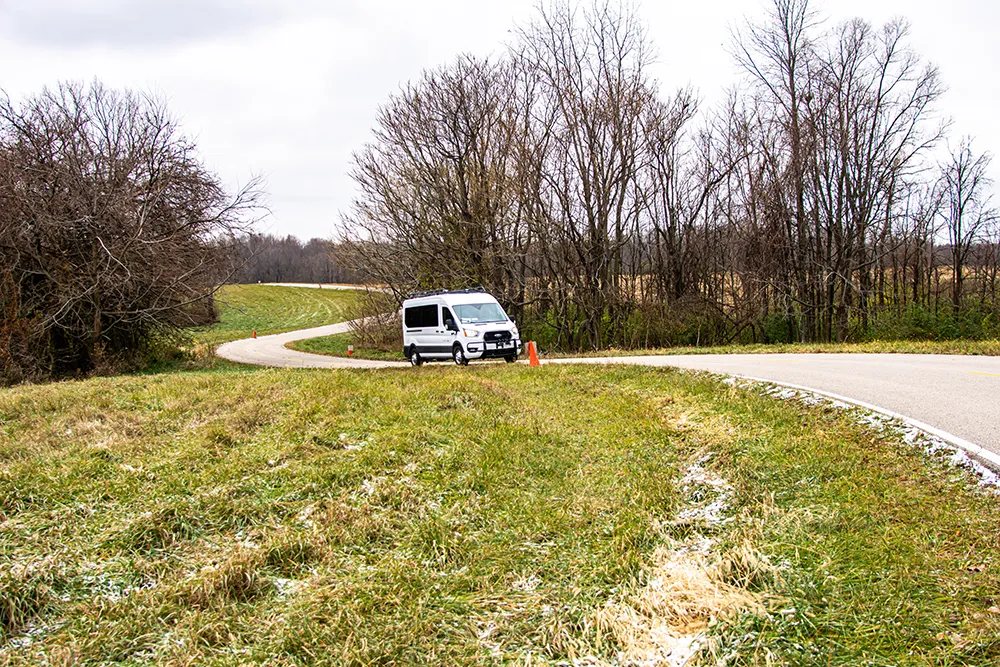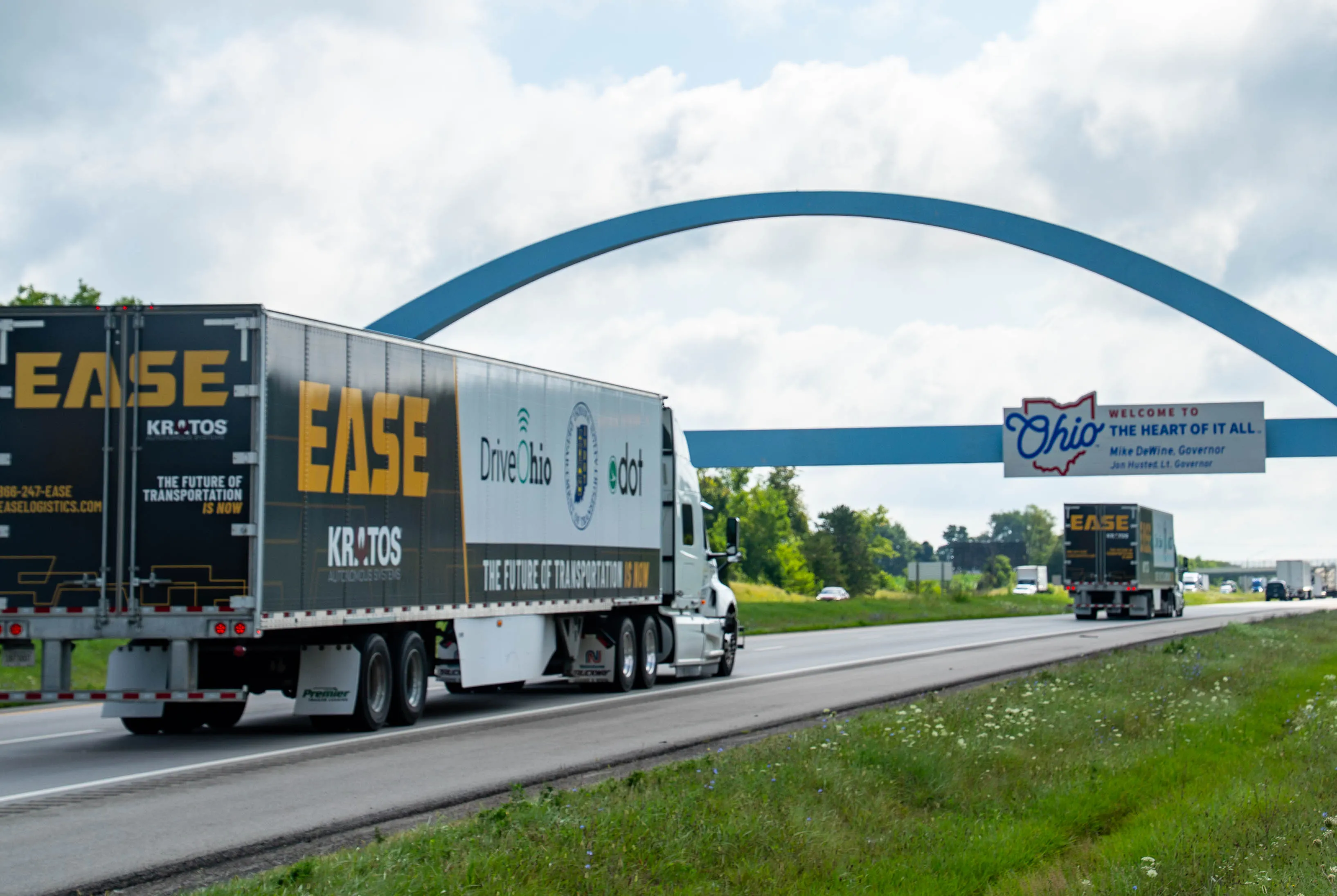
There is rising enthusiasm in America and beyond for the concept of truck platooning with trials being planned in several US states, as David Crawford reports.
Growing numbers of US states are considering or implementing plans for trials of electronically-linked truck platooning on public road networks. This is in response to the interest being shown by the US$70bn a year road freight industry, where fuel represents 41% of the operating costs making the prospect of improving fuel economy by trucks travelling closer together and reducing aerodynamic drag very appealing.
Critical to the acceptance and success of this is the ability to maintain constant distances between platooning vehicles more accurately and safely than is possible with manual controls. Emerging solutions deploy elements of a cooperative-vehicle version of adaptive cruise control (C-ACC) technology - notably in engine and brake actuation. These are combined with sensors, including forward-looking radar, and V2V links using dedicated short-range communications, to enable a following truck(s) to mimic, within milliseconds, the movements of the lead one.
In bearing the brunt of the aerodynamic load, the lead vehicle benefits less than the other(s) following in the more benign low air pressure cocoon it creates. But average overall fuel savings for a two-unit platoon, travelling in real-world operating conditions, are put at 4% and upwards, after taking account of traffic and terrain conditions.
The savings are environmentally as well as economically important because trucking is responsible for nearly 75% of total US freight energy use and greenhouse gas emissions. Articulated, or combination, trucks (tractor units with attached trailers) account for 65% of this consumption; in 2014, they drove 273bn kilometres (170bn miles) across the US and in the process consumed 110bn litres(29bn gallons) of diesel fuel and emitting the equivalent of 295 million tonnes of CO2.
With US truck sales forecast to rise up to 2024, the importance of improving fuel efficiency is becoming increasingly evident. The US National Renewable Energy Laboratory (NREL) has calculated that, theoretically, almost 66% of the distance currently driven by combination trucks could be covered in platoon formation.
In its presentation to the Society of Automotive Engineers (
It sees trucks as offering ‘ideal applications’ of platooning, due to their technical characteristics and mode of operation, with many vehicles driving for long distances along the same routes, which are often concentrated in a few major corridors. A key advantage cited for platooning is that it can be implemented without the need for a major redesign, or technological changes to, existing vehicles.
The laboratory sees its findings as complementing existing research which, it says, did not take account that not all the trips are suitable for platooning. It also points out that, in the real world, operators may not always be willing to use it – for example, because they don’t want to have to wait to form a platoon.
It is planning to assess industry levels of willingness to make use of the system, identify other barriers to its widespread adoption and refine its estimates of potential savings accordingly.
Meanwhile, the political support is growing with Michigan governor Rick Snyder among the most active backers. In December 2016 he authorised an exception, for platoons, to the Michigan vehicle code’s stipulation of a minimum 152m (500ft) following distance for commercial vehicles – a larger figure than in most other US states.
In step with Snyder’s initiative, preparatory off-road system testing will run at the recently established American Center for Mobility, based at a
In January 2017 the
Arkansas and Tennessee have also initiated legislation to allow truck platooning, with reduced following distances. Similar efforts are under way in Iowa, South Carolina and Tennessee. Utah has already moved to allow on-road trials (see below).
Trialling today
In August 2015, automotive systems specialist
The exercise involved two simultaneous trials, using identically specified 2011 model year Peterbilt trucks with similar diesel engines and manual transmissions provided by Peloton, which installed its platooning technology. Each truck pulled a fully laden CR England trailer. The test ran at 102km/h (64mph) with, once the platooning technology was engaged, an 11m (36ft) gap between the platooning vehicles.
It covered six segments, each of approximately 64km (40 miles), along Interstate 80 west of Salt Lake City, in normal highway conditions among other vehicles. The trucks carried specially manufactured fuel tanks, fed by hand pump from standard ones, that were weighed before and after each test segment and a full day’s run, using the same portable scales in all cases.
Tyres were checked for the appropriate pressure, and the testers noted weather and traffic conditions. The results showed the lead truck achieving an average fuel saving of 4.5% and 10% for the following one.
Peloton Technology’s Jonny Morris told
“We ensure these conditions through our cloud-based network operations centre, which monitors the movements of the trucks and geofences the use of the platooning system to allow its operation only on approved roads and in the right conditions.”
Utah incorporated changes enabling truck platooning in authority for truck finalised in its 2015 legislative session.
Last autumn, three trucks platooned at
Meanwhile, the USDoT’s
In March 2017 they staged a demonstration along interstate I-110 near the Los Angeles-Long Beach Port conurbation. Visitors rode in following vehicles in a C-ACC controlled platoon and experienced the system responses when an intruding passenger car cut in between. An FHWA spokesperson told ITS International that the exercise demonstrated the safe separation of the string and the resumption of short-gap operations once the invasive car moved out.
The second project, involving Alabama’s
Savings estimates
The
It said large fleets could expect to see a return on the cost of investing in the equipment within 18 months, while small fleets might achieve this more quickly, within 10 months.
Another study, by Washington, DC-based Trucking Efficiency, indicates that two-vehicle platoon gaps of up to 16m (50ft) are likely to offer a sufficiently attractive initial payback for early adopting fleets, with higher fuel savings attainable later in line with progressive product improvements.
Hybrid platoons
In a further initiative, Montana State University’s Western Transportation Institute (WTI) is running a new Collaborative Human-Automated Platooned Truck Alliance (CHAPTA). Its industry-guided and -funded research team is exploring the scope for hybrid platoons that combine human driven/supervised trucks with driverless ones in a single convoy – with the emphasis on human factors and safety.
Senior research engineer Professor Craig Shankwitz told ITS International: “We’ve modelled a number of scenarios, and concluded that a combination of five trucks operated by two drivers could achieve around 25% in operational savings. The hybrid approach appears to be the most suited to today’s climate.
“SAE level-8 autonomous trucks are not yet ready for the road. Again, the ‘driver in every truck’ model fails to address the issue of labour shortages, and is not viable from both human factor and economic perspectives. Ours addresses the shortage issue, eases fears about autonomous trucks on the highway, focuses on the human element of the platoon and provides a clear return on investment in autonomous vehicle technology.”
Initial research will take place using the Institute’s driving simulator, with the goal of understanding more clearly the needs of drivers in a platoon. “For instance,” asks Shankwitz, “how closely can a human follow a lead truck over an eight-hour shift without excessive stress or boredom?
“Once we have simulator-based answers, we will move to field trials; first at our test track and then on public roads.” The Institute’s Transcend track offers over 6km (10 miles) of paved roads on decommissioned airport runways.
Shankwitz cites activity from Asia, where the Singapore Ministry of Transport and the Port of Singapore Authority have recently signed agreements with truck manufacturers to develop hybrid systems suitable for deployment on public roads.










